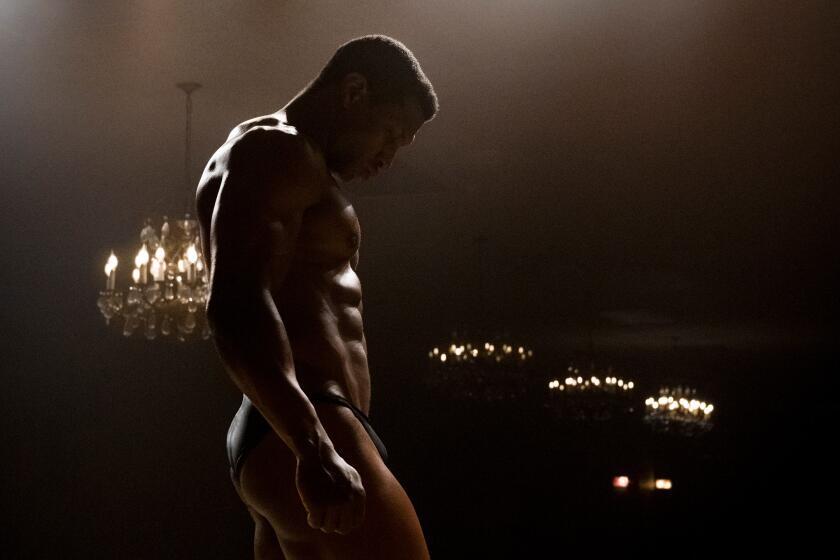‘Spitfire,’ ‘Night’ Heat Up Sundance
- Share via
PARK CITY, Utah — The scene opens on a smoky assembly line, with stolid workers taking identical cans of film and pushing them through slots of the same size, again and again and again.
But wait. Here’s a film that doesn’t fit. Alarm bells go off, a crack team appears and thrusts the oversized can into a yellow box marked “Sundance International Film Festival.” “Where do they take it?” someone asks as the offending item disappears inside a departing truck. A co-worker gives a laconic, one-word answer: “Utah.”
This clever bit of film, which starts every one of the festival’s screenings, exactly summarizes Sundance’s pleasantly satisfied self-image. And the sense of privilege it exudes extends to the festival-goers themselves, who for the most part remain cheerful and happy to be here despite more-than-usual difficulties.
For one thing, a continuous series of storms has deposited more than three feet of snow in town, the most the festival has seen in at least a decade, keeping some films from arriving and leading to postponed and canceled screenings. And the kind of wall-to-wall crowds that in the past have only appeared during the festival’s closing weekend started gathering here from Day 1.
Still, the festival’s youthful, summer-camp-in-winter ambience, typified by the director who cheerfully announced before a screening that his film was “made entirely without adult supervision,” is as strong as ever. When one of the festival organizers said “hi” to an audience, they roared “hi” right back. And so much schmoozing and greeting goes on in the theater aisles that it’s invariably difficult getting people seated to start the film.
Given all of this, it’s fascinating to note that, in the event’s early days at least, the two films most talked about in the dramatic competition have been gentle, conventionally well-made pieces of work with recognizable stars. That these are films that wouldn’t fit into regular movie business slots says more about Hollywood than it does about Sundance.
Very much a performer’s piece is “Big Night,” co-directed by actors Stanley Tucci and Campbell Scott from a script Tucci co-wrote. Set in the 1950s, “Big Night” is a satisfying comedic drama, both delicate and deliberate, about two brothers recently arrived in the United States from Italy to start a restaurant.
While front man Secondo (played by Tucci) is concerned about financial success, chef Primo (Tony Shalhoub) is a finicky purist who finds it impossible to sacrifice his principles. Centering on an unforgettable meal that ranks with the feasts of “Babette’s Feast” and “Eat Drink Man Woman,” “Big Night” is most effective with its character moments as it passionately celebrates the notion that “to eat good food is to be close to God.”
*
“Care of the Spitfire Grill,” written and directed by TV veteran Lee David Zlotoff, the creator of “MacGyver” and former supervising producer of “Remington Steele,” benefits most from its lead performance. Alison Elliott, who was the best thing in Steven Soderbergh’s “The Underneath,” stars as Percy Talbott, a young woman recently out of prison who chooses the small Maine town of Gilead as the place to start a new life.
As that choice of town name indicates, “Spitfire” has a tendency to be schematic and predictable. But that is balanced by the care with which it’s been made, and by Elliott’s feisty and touching performance, good enough to positively influence the work of co-stars Ellen Burstyn and Marcia Gay Harden.
One film not causing much of a stir is “Ed’s Next Move,” because, in one of those mysterious lapses of judgment the festival is prone to, it was not deemed worthy enough for the dramatic competition. Written and directed by John Walsh, it stars Matt Ross as a timid country mouse from Wisconsin who moves to New York and falls under the romantic spell of quintessential city girl Calliope Thorne. A sweet-natured and endearing romantic comedy, “Ed” has considerably more going for it than some of the tarted-up competition films.
*
One of the more satisfying pieces of acting seen so far is Lily Taylor’s success in bringing to life Valerie Solanis, founder of SCUM (Society for Cutting Up Men) and the protagonist of Mary Harron’s “I Shot Andy Warhol.” The busiest actress here with appearances in two other films, Taylor is the most celebrated of a group of performers like Catherine Keener, Anne Heche and Kevin Corrigan (who all co-star in the genial “Walking and Talking”), whose work has become familiar to festival-goers even if their names sometimes are not.
Not any kind of name at all, though his attitude epitomizes the spirit of many people who come here, is 29-year-old aspiring writer-director Garry Grant Dinnerman, a graduate of Georgia State’s film school whose short, “Outside Looking In,” was turned down by the festival.
Nothing deterred, Dinnerman rented a corner room at the Treasure Mountain Inn on Main Street, hung a banner advertising his film from the balcony and even projected a slide announcing screenings in his room on the wall of a building across the street, next to a Mrs. Fields sign. He faxed notices of his intention to about 200 potential viewers and spends much of his time in his hotel room (which has a prankishly faked autographed photo of Robert Redford calling “Outside Looking In” “truly the best short film I’ve ever seen” on the door) waiting for an audience to arrive.
“If I could have somebody from Fine Line or Touchstone or an agent come by and look at it, I’ll be happy,” he says cheerfully. Only six people showed up the first day, but Dinnerman was undaunted. “The festival,” he says, “is just getting started.”
More to Read
Only good movies
Get the Indie Focus newsletter, Mark Olsen's weekly guide to the world of cinema.
You may occasionally receive promotional content from the Los Angeles Times.











